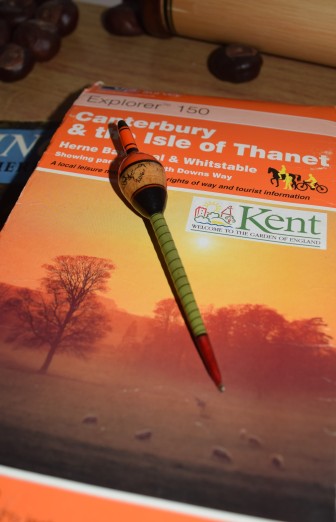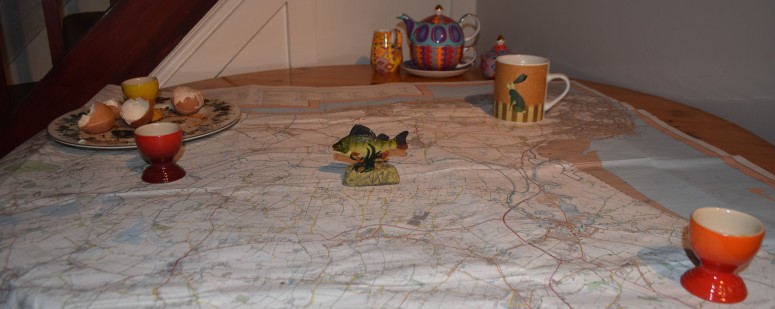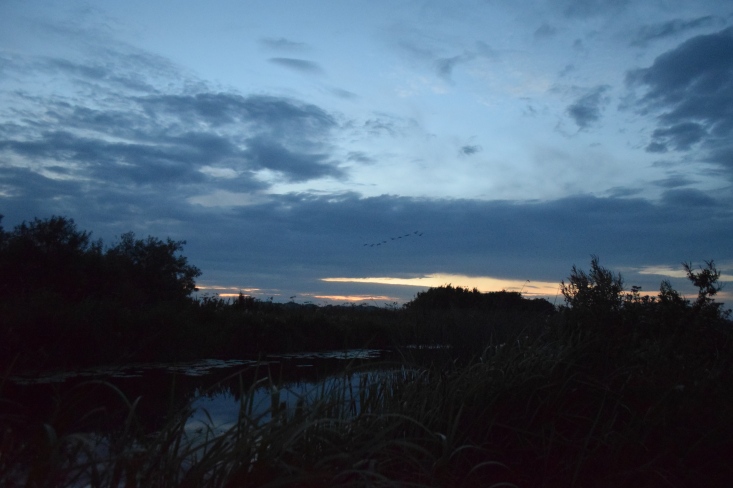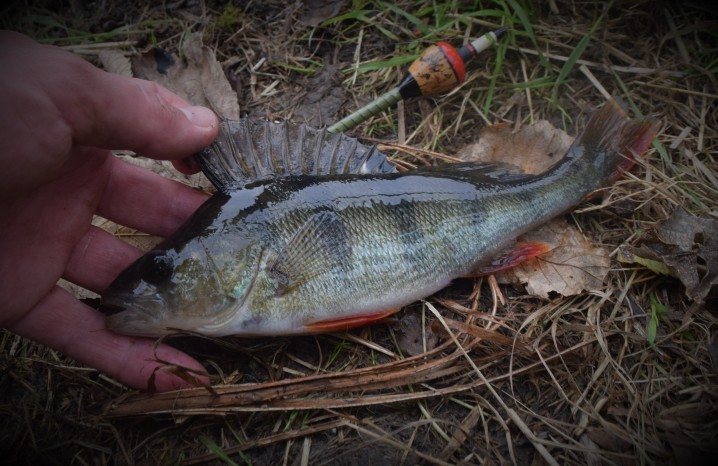“He found himself wondering at times, especially in the autumn, about the wild lands… Strange visions of mountains that he had never seen came into his dreams”
J.R.R.Tolkien, ‘The Fellowship of the Ring’
The Wild Perch of Black Dyke
Part Two: The Misty Marsh

About seven years ago, I moved from London back down to Kent. Prior to my return, I lived in the middle of Putney Heath, which was heavily wooded and full of wild creatures. Getting back from my favourite local- ‘The Green Man’- meant a lovely night walk through fox and owl country, with the former terrifying and the latter serenading me with their respective calls. When I first arrived back in dearest Cantium, I stayed with a mate in North Foreland, which is also crawling with foxes. And the local pub was pretty good, too- the ‘Nineteenth Hole’. But there were no owls. The whole isle of Thanet is bereft of them. What’s more, you have to drive out of town to get any decent freshwater fishing.
Hungry to recreate the country adventures of my misspent youth, I rapidly re-joined two of my old coarse fishing clubs, signed up with a fly fishing syndicate and put my name down for the Kent Wildfowlers. Within weeks, I was sent various sets of keys, gate codes and guide books telling me where to park, where to fish and what I could and couldn’t shoot. On the latter front, I was somewhat of a novice; I grew up with rods- not rifles. However, I soon became a competent shot and even managed to bag a few wild rabbit for the table. At the time I was the headmaster of a small school in Margate but it wasn’t long before I developed the dual persona possessed of all die-hard fishermen and hunters. On Monday morning, I’d be all business, organising time-tables and sorting out the school finances but as the week went on, something was growing inside of me. By Thursdays, all I could think of was the weekend. Fridays were virtually unbearable- especially as I’d have to work until nine or ten ‘o’ clock at night to make sure the weekend was my own. But when I looked into the mirror early on a Saturday morning, the transformation was complete… The man who stared back at me was no longer a teacher but instead a dyed-in-the-wool Kentish cowboy, desperate for fishing, ale and fresh air.

One of my early escapes was into the Blean Woods, a 7 mile wide ancient forest situated between Canterbury and Faversham. At the time, there was a huge rabbit problem in this part of the countryside; the local rifle club ended up giving me well over a dozen locations (probably about eleven more than I could handle) to shoot over- all on old farms and bits of rough land around the ‘Blean’, as it’s affectionately known. Back then, I didn’t know the woods very well and was soon wasting both time and petrol driving the long way from site to site. However, I do have a good sense of direction and before long I’d internalised a map of sorts. My ‘territory’ started to the east of the forest and ended just outside the village of Dunkirk, to its west. Along the way, a bric-à-brac of lovely Kentish place names such as ‘Plumpudding Lane’ and ‘Holly Hill’ served to enhance my inner map. After a while I felt like I knew the area pretty well.
However, I got it very badly wrong in one particular spot and ended up carrying a rifle around a farm where I didn’t have permission. Luckily, the area was well out of the range of any walking routes- but unluckily, it was well within the range of the farmer and his two burly sons. I’d actually been frequenting the location for around two months before I was caught; it remains one of the most beautiful spots I’ve ever seen in my life. The farm was hidden in a valley, the top part of which afforded stunning views of the Medway Estuary. From here, I would descend at dusk, stalking my way along an enormous bund that ran down the middle of the hill. The bund was thick enough for me not to be able to hear the huge pheasant pen that resided somewhere deep within it. Pheasants are worth £40 a pop (or whatever it is these days- I wouldn’t know as I’m too poor to shoot them) and farming folk take very unkindly to armed raiders in the vicinity of their feathered honey-pots.

I’ve had run-ins with both gypsies and farmers whilst fooling around in the Kentish wilds and I’d be hard-pressed to state which were the tougher; the farmers who confronted me at this particular location looked like extras from the film ‘Deliverance’. The incident began when I saw an old Range-Rover pull up and three men jump out with shotguns. Summoning up all of my courage, I immediately dodged into the bund and hid… After a while, it was obvious they were coming my way so I emerged and began to casually walk up the hill. I would have affected a whistle, if only my mouth were less dry. When we came face to face, I noticed that the third ‘man’ was in fact a lad of about fourteen who looked to weigh around 15 stones or so.
He stopped first and looked at the men, grinning. I guessed his thoughts- something along the lines of ‘Can I shoot him, Pops? Can I?!?’ I reacted by affecting my doddery teacher act and started talking about how many rabbits there’d been tonight and how varied the birdlife was locally. Not for the first time, it worked. Possibly the best way to avoid a whipping from the Kentish farming fraternity is to sound as ‘un-gypsy’ as possible. They let me off, and even gave me directions to the farm where I should have been- a mile or so up the road.

I’d made a bad mistake. Wandering around whilst armed can get you in a heap of trouble in southern England, where an honest hunting rifle is seen as worse than a nuclear weapon. I was young and had been over-confident. I’d also been using ‘Google Earth’, which is rubbish compared to an Ordnance Survey map. I picked one up soon afterwards and it’s been my trusted friend ever since; it’s far more detailed than sterile old google, and much more real. Mine has begun to age with me, and there are various markings/creases that show places where I’ve had particularly good adventures. It’s accompanied me on night missions to listen to nightjars and it’s helped me to locate huge, wild tench- some of which, I even caught…

After a while, the quadrant which represents my local ‘patch’ became something more than a map. I can look at it now and see not just experiences- but dreams for the future. The darker egg cup in the picture below, near what’s left of my breakfast, represents a great bend in the Stour where I caught my biggest river perch. The lighter egg cup, in the right-hand corner, represents a big tench… The biggest of them all.

The mug in the map represents Thanet (where I live), whilst the perch figurine represents the open country. Thanet used to be an island; it was separated from the rest of England by the Wantsum Channel. Consequentially, the lowland area between here and Canterbury, and as far south as Deal, is a watery nether-realm that takes in two main river courses (the Kentish Stour and Wantsum) as well as a plethora of bournes, streams, dykes, drains and, in places, big tidal lakes. On top of this, there are the various dents and craters left over from the Industrial Revolution: I learned to float fish in an old brick-pit and have caught pike from the settling pools that were dug to stem flooding from my grand-father’s old colliery… All of this water can be exploited by the thoughtful coarse angler. Much of it has already been bundled into various clubs, associations and commercial fisheries. But a huge amount remains outside club control, which leaves you free to roam, think and fish- all without paying a penny or having to wait your turn for a favourite spot.
The coastal marshes and their drainage dykes have been of particular interest to me over the past few years; I’d never encountered a single other angler on the marshlands until this season, when I met two. The first was a young gamekeeper, who came rolling up in yet another, ubiquitous Range Rover straight down the track I’d just spent 40 minutes walking down (the jammy bugger had keys to every bridle gate in the area); it was a shock at first as usually if you see anyone out there, it’s through binoculars. It was June 15th, the day before the season opened, and we’d both come to scout for tench. As we were talking and looking at the water, a fish of around six pounds momentarily drifted out into the open channel before shooting back into the cabbage like a rocket. We both saw it. Having tasted their power first hand, I recovered slightly more quickly; when I looked at the gamekeeper, he’d turned rather pale- a fellow tench angler if ever I saw one. I couldn’t resist telling him where I felt the best patches were.
In turn, he filled me in on a separate spot where he’d enjoyed excellent perch fishing last season. Again, it would be marshland coastal dykes- which usually results in the fish being perfectly marked and in pristine condition. The marsh tench I’ve caught all looked like oil paintings. Our current location had produced perch for me but they were tiny, stunted fish. However, they were all immaculate looking creatures, with jewel-like markings; the prospect of catching a larger specimen, a real dragon, was mouth-watering, especially when I learned they ran to over three pounds on this other stretch. He told me roughly where his spot was and described some key features of the location, notably a series of sluices and some great bends in the drains.

We bade farewell and he walked off into the marsh. I never saw him again- as so often happens with these country adventures. After he’d left, I commenced weed-raking a couple of tench marks where I’d previously been successful. Just before dusk, I stopped for my usual tea break when I saw a second figure approaching purposefully from the south. I was submerged by the reeds and at first all I could see was a head bobbing up and down in the near distance. My mind started to race; the marshes are well known to be haunted. Could this be the ghost of old Mick, the kindly fellow who first told me about the ‘saltwater tench’ so many moons ago? As the apparition came closer, I realised it was human. And definitely not Mick. This man was a younger, much wilder looking fellow, with long hair running down over his shoulders and a determined, steely gaze… I decided to keep ducked down a while longer.
Luckily, it was none other than fellow outlander Dylan Wrathall, a man rightly respected in Kentish angling circles for his uncompromising approach to wild fishing. Dylan is possibly the only human I might actually expect to meet in such a location, although we’d never bumped into each other before now. When eventually I poked my head up, it was like Butch Cassidy meeting the Sundance Kid. We sized each other up for a while, exchanging a few suspicious glances before finally introducing ourselves. We hit it off immediately and had a good chat about the location and our differing styles. I’m a wandering float angler whereas Dylan has his own style altogether- a bit like Richard Walker meets Crocodile Dundee. He’s caught wild marsh carp to over twenty pounds, as well as some huge pike from these isolated waters. The marsh carp (or ‘plains’ carp as I’ve taken to calling them) are a unique-looking, bronze strain of the common carp that have to be seen to be believed: many of Dylan’s captures are featured in his online journal ‘Of Esox and Observations’. Thus far, I’ve fished the marshes solely for tench, so we’ve very much been ships that pass; but it was fascinating to be able to talk about these lonely spots with somebody else who ‘knows’. Neither of us mentioned the gamekeeper, but it would later transpire that we both encountered him that day…

When I got home, I took out my O.S map and pinpointed some spots which seemed to fit with what the keeper had told me. If true, it was an area that I sometimes drove past on my way to other marks. Time passed and in late August, I drove out to the marsh with some binoculars and a flask of tea. I found sluices, bridges, and willow-banked swims; open country and the outskirts of a village; and amazingly varied wildlife, too. Kingfishers, hobbies, kestrels- and evidence of beavers, although I wouldn’t actually see one until I started fishing
My search narrowed upon a single, meandering drain of less than a mile long that passes through a series of sluices before widening into beautiful open country. I’ve come to call it Black Dyke; the ordnance survey doesn’t give the water a name- just a geographical term- and whilst it’s part of a wider system that is titled, this section is quite distinct. Moreover, every other dyke, puddle or ditch around these parts already has a colourful Kentish name, so I didn’t see any reason why this stretch shouldn’t have its own. I chose Black Dyke on account of the water quality- which is perfect. The clarity is so good that the surface reflects the bottom, which I’ve plumbed down to eleven feet in places, so it’s anyone’s guess how deep it will be in the winter. The resulting surface sheen runs a deep, dark onyx and – as seems common with very clear water- the resident fish would prove to possess a distinctly dark tinge to their perfectly marked hues.

Having done most of my searching in bright, blue sky conditions, I eventually chose a foggy afternoon in late September to make my first armed raid with rod, rucksack and a few other bits- chief amongst them a pot of worms. I had a week spare and I intended to spend at least five days of it fishing. The fog came on the first day, and although it’s not always wise to walk a misty marsh, I was keen not to waste any time.
Picking the most likely spot to start my adventure, I chose a large sluice towards the end of the drain and cast a huge lob-worm in next to the gate. The weather can change very quickly out on the marsh; a thick coastal fog can form in a matter of just minutes. This one had risen slowly but was now very rapidly devouring everything in sight- including my float. Sometimes the fogs out here can seem almost supernatural; as though an ancient dragon has been revived and is busy breathing his spirit all over the surrounding landscape.

As I sat anticipating what might come, the fog deepened and deepened until it hung like a woollen blanket over the entire marsh. The afternoon turned to dusk and I could only just about see the brightest part of my float- when at last it started to bob up and down… The dragon had spoken, and I reeled in one of his descendants: a tiny wild perch- but in perfect, dark-hued condition. The season had finally begun. But before I could attempt to catch something bigger, the conditions worsened and I made the decision to return home, almost missing the track which led to my car, save for the lights of a departing farm-worker.

After a while the fog seemed to get everywhere and into everything- including me. I went very heavily to bed that night. Not long afterwards, I felt myself being carried into a deep, deep sleep where I would dream of giant, perfectly marked perch and a stream so black I might get drawn into it if I looked for too long.
When I awoke the next morning, I cancelled any outstanding appointments I had during the following week. There was no point trying to fight it; I was lost upon the wings of the dragon…
… But there’s no other place a perch fisher would rather be.

Interesting read. Keep up the good work.
LikeLiked by 1 person
Most kind of you to say, James! I shall keep going- Best Regards, Gazza
LikeLike
That was just all very lovely and you write very well: a gorgeous invocation of place and time, replete with a tingling expectation of the next part…when I’m guessing the dragons are made real!
LikeLiked by 1 person
Thank you, Kate! Very kind of you to say so. Yes, you’ve guessed well- the dragons are coming! There are two more instalments to come- it was a great adventure and I’ll go back from time to time… Best Regards, Gazza
LikeLike
Splendid. Again.
LikeLiked by 1 person
Thank you BB! Very much appreciated! More to come. Two more, in fact. The main part of my adventure is now over- I just need to write it up… But I’ll go back here and there. There are some dykes nearby that look good for piking and I know that Dylan has already taken one whilst perching… We shall see- a long winter beckons… Best Regards, Gazza
LikeLike
Not too sure that Dick Walker and I are worthy of mention in the same sentence? He was, after all, an angling genius and I’m a maggot drowner by comparison. Mick Dundee – yes that’s far more to my liking and much closer to reality although I haven’t had to wrestle any crocodiles yet.
Another fabulous piece, superbly written, as always.
Take care & tight lines – Dyl
LikeLiked by 1 person
Hello mate- I’m glad you liked it! Crocodiles aside, I’m quite sure we’ll both be wrestling dragons at some point this autumn… Speak soon, Gazza
LikeLike
All I can say is WOW,that was a really interesting read ,I enjoy every word it was has if I was there with you.
LikeLiked by 1 person
Thank you for such kind feedback, John- it’s genuinely appreciated and I’m glad you enjoyed it! There will be two more entries on Black Dyke, and then who knows? Perhaps a roach or a pike adventure? Best Regards, Gazza
LikeLike
Gareth, A wonderful read and the area sounds so like the West Norfolk fenland. I shall add your site to my Two Terriers ‘Blogs I follow’. Very enjoyable, thank you and keep it up. Regards, John
LikeLiked by 1 person
Hello John, So glad you enjoyed it; where I’m fishing is very near to Kent’s last remaining bit of fenland. It’s small compared to Norfolk but a lovely escape.Thanks very much for the add, too- Best Regards, Gazza
LikeLike
A lovely article, now I have to go to the very beginning and start again. The landscape is very evocative and reminds me of my patch in the West Norfolk Fenland. I’ll add your site to my blogs I follow for easy access. Kind regards, John
LikeLiked by 1 person
Good to hear!- Hope you enjoy the story, John- That was my usual autumnal sprint for the perch. I’ve since had a go for the pike but I’m already starting to crave winter perch fishing- I have another spot just waiting… Fingers crossed… Merry Christmas, Gazza
LikeLike
superb descriptive, imaginative writing, so much anticipation building , makes me pine for the marsh and “wild fishing”
LikeLiked by 1 person
Thank you, Phil- Very kind of you to say… For me, our marshes are one of our great ‘outbacks’ along with our woods and coastline. I adore fishing and bird-watching my local stretches of marshland. And the perch are so vivid! Thanks so much for reading- Speak soon, Gazza
LikeLike